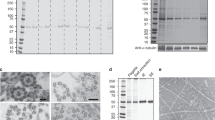Summary
The surface of the contractile ciliateSpirostomum contains continuous spiral ciliated grooves traversing its length. Bundles of microtubules run parallel to the base of the grooves and appear to be part of a cohesive, semi-rigid cortex. Beneath this, a network of microfilament bundles occurs which is attached to the peristomal membranelle apparatus, also part of the cortex. The possible roles played by these structures during contraction of the organism were examined.
During contraction, the entire cortex twists and the spiral arrangement of the grooves and microtubules decreases in pitch and increases in diameter. Simultaneously, the bundles of microfilaments change in distribution and appearance so as to suggest that they are undergoing an active shortening process. Based on these observations, two models for contraction are presented. In one, shortening of the animal arises from a smooth muscle-like contraction of the microfilament network whose attachment to the basal bodies of the membranellar cilia guarantees shortening and widening of the cortex and consequently the whole animal. In the second, a shortening (or sliding) of external microtubules relative to internal ones in the cortical microtubule bundles would result in an increase in diameter, a decrease in pitch, and a decrease in axial length of the bundles, resulting in contraction of the animal. The observations do not allow a choice between these alternatives to be made, and they may not, in fact, be mutually exclusive.
Similar content being viewed by others
References
Allen, R., 1965: Cytoplasmic streaming and locomotion in marineForaminifera. In: Primitive Motile Systems in Biology (R. Allen andN. Kamiya, eds.), pp. 405–430. New York and London: Academic Press.
Bannister, L., andE. Tatchell, 1968: Contractility and fibre systems inStentor coeruleus. J. Cell Sci.3, 295–308.
Boggs, N., 1965: Comparative Studies onSpirostomum: silver impregnation of three species. J. Protozool.12, 603–606.
Burdwood, W., 1969: Unpublished results.
Daniel, W., andC. Mattern, 1965: Some observations on the structure of the peristomal membranelli ofSpirostomum ambiguum. J. Protozool.12, 14–34.
Dembitzer, H., andH. Hirshfeld, 1966: Some cytological observations on the heterotrichous ciliate,Blepharisma. J. Cell Biol.30, 201–205.
Fauré-Fremiet, E., P. Favard etN. Carasso, 1962: Étude au microscopie électronique des ultrastructures d'Epistylisanastatica (cilie péritriche). J. Microscopie1, 287–312.
Finley, H., C. Brown, andW. Daniel, 1964: Electron microscopy of the ectoplasm and infraciliature ofSpirostomum ambiguum. J. Protozool.11, 264–280.
Fisher, R. A., 1950: Statistical methods for research workers. 11th ed. Edinburgh: Oliver & Boyd.
Grain, J., 1968: Les systems fibrillaires chezStentor igneus Ehrenberg etSpirostomum ambiguum Ehrenburg. Protistologica4, 27–36.
Harris, P., 1962: Some structural and functional aspects of the mitotic apparatus in sea urchin embryos. J. Cell Biol.14, 475–487.
Grimstone, A., andL. Cleveland, 1965: The fine structure and function of the contractile axostyles of certain flagellates. J. Cell Biol.24, 387–400.
Inoué, S., andH. Sato, 1967: Cell motility by labile association of molecules. J. Gen. Physiol.50, 259–292.
Jahn, T., andE. Bovee, 1964: Protoplasmic movements and locomotion in protozoa. In: Biochemistry and Physiology of Protozoa, Vol. 3 (S. Hunter, ed.), pp. 62–129. New York and London: Academic Press.
Jones, A., T. Jahn, andJ. Fonseca, 1966: Contraction of protoplasm I. J. Cell Physiol.68, 127–133.
Kane, R. A., 1962: The mitotic apparatus fine structure of the isolated unit. J. Cell Biol.15, 279–287.
Luft, J., 1961: Improvements in epoxy resin embedding methods. J. Biophys. Biochem. Cytol.9, 409–414.
McIntosh, J. R., P. K. Hepler, andD. G. Van Wie, 1969: Model for mitosis. Nature224, 659–663.
—, andK. R. Porter, 1967: Microtubules in the spermatids of the domestic fowl. J. Cell Biol.35, 153–173.
Nagai, R., andN. Kamiya, 1966: Movement of theMyxomycete plasmodium II. Electron microscope studies on fibrillar structures in the plasmodium. Proc. Japan Acad.42, 934–939.
—, andL. Rebhun, 1966: Cytoplasmic microfilaments in streamingNitella cells. J. Ultrastruct. Res.14, 571–589.
Pitelka, D., 1969: Fibrillar systems in flagellates and ciliates. In: Research in Protozoology, Vol. 3, in press. Oxford: Pergamon.
Randall, J., andS. Jackson, 1958: Fine structure and function inStentor polymorphous. J. Biophys. Biochem. Cytol.4, 807–830.
Rebhun, L., 1967: Structural aspects of saltatory particle movement. J. Gen. Physiol.50, 223–239.
— andG. Sander, 1967: Ultrastructure and birefringence of the isolated mitotic apparatus. J. Cell Biol.34, 859–883.
Reynolds, E., 1963: The use of lead citrate at high pH as an electron opaque stain in electron microscopy. J. Cell Biol.17, 208–212.
Satir, P., 1967: Morphological aspects of ciliary motion. J. Gen. Physiol.50, 241–258.
Stempak, J., andR. Ward, 1964: An improved staining method for electron microscopy. J. Cell Biol.22, 697–701.
Tilney, L., 1968: Factors governing the organization of microtubules in the axonemal pattern inActinosphaerium nucleofilum. J. Cell Biol.39, 136 a.
— andK. Porter, 1967: Studies on the microtubules inHeliozoa II. J. Cell Biol.34, 327–343.
Wohlfarth-Bottermann, K., 1964: Differentiations of the ground cytoplasm and their significance for the generation of the motive force for ameboid movement. In: Primitive Motile Systems in Biology (R. Allen andN. Kamiya, eds.), pp. 79–107. New York and London: Academic Press.
Wohlman, A., andR. Allen, 1968: Structural organization associated with pseudopod extension and contraction during cell locomotion inDifflugia. J. Cell Sci.3, 105–114.
Yagiu, R., andY. Shigenaka, 1963: Electron microscopy of the longitudinal fibrillar bundle and the contractile fibrillar system inSpirostomum ambiguum. J. Protozool.10, 364–369.
Author information
Authors and Affiliations
Rights and permissions
About this article
Cite this article
Lehman, W.J., Rebhun, L.I. The structural elements responsible for contraction in the ciliateSpirostomum . Protoplasma 72, 153–178 (1971). https://doi.org/10.1007/BF01279048
Received:
Revised:
Issue Date:
DOI: https://doi.org/10.1007/BF01279048




